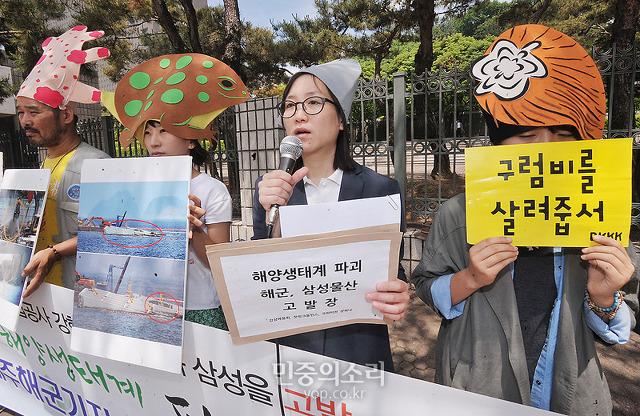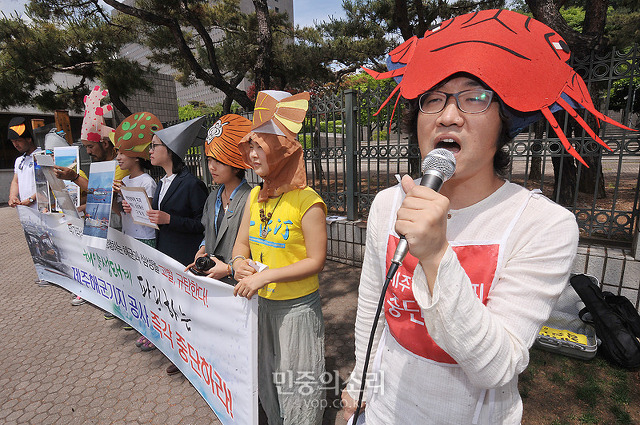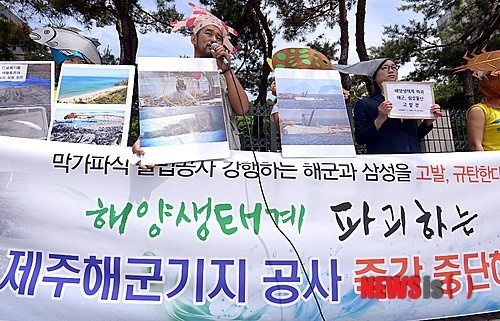In this month’s issue:
Soft corals of Gangjeong dying, Jeju after the elections, Sydney Harbor, Solidarity with Okinawa for the Battle of Okinawa, police disturb Catholic mass, village bus gets painted, nonviolent direct action workshop in Gangjeong, remembering the Korean war, noisy construction, prison updates, trial updates, international solidarity, and more!
Save Jeju Now
No War Base on the Island of Peace
Tag: UNESCO
-
Soft corals seriously were damaged in two years in violation of the EIA
Soft corals seriously were damaged in two years in violation of the EIA: The base construction should be immediately stopped!

Before (2012) and AFTER (2014): Serious damage has occurred in soft corals in the directly impacted areas due to the Jeju naval-base construction. Source provided by people’s team by the result of monitoring from June 11 to 13, 2014 
Before (2012) and AFTER (2014): Serious damage has occurred in soft corals in the directly impacted areas due to the Jeju naval-base construction. Source provided by people’s team by the result of monitoring from June 11 to 13, 2014 
The sites that people monitored this time. A is the area of a light house and B is the area of the Seogeon Island. 
The wrong sites the ROK navy has conducted monitoring. Compare it from the image above. On June 18, the widely reported in Korean media was the result of the international workshop to investigate on the impact on Jeju sea soft corals caused by the naval base construction, which was a follow-up of the ‘International Symposium on the Conservation of Soft Corals in Asia-Pacific: Impact of Military Bases on Soft Coral Communities,’ National Assembly seminar hall, Seoul, June 10.
The whole workshop and site investigation (June 11 to 13) was organized by the Gangjeong Village Association, Jeju Pan-Island Committee for Stop of Military Base and for Realization of Peace, National Network of Korean Civil Society for Opposing to the Naval Base in Jeju Island, and Office of Jang Hana, National Assembly Woman .
The task force team on the monitoring of the soft corals in the Jeju naval base construction area included Dr. James E. Maragos, U.S Fish and Wildlife Service, a member of the soft coral expert group, IUCN; Dr. Simon Ellis, Marine and Environmental Research Institute of Pohnpei; Dr. Abe Mariko, The Nature Conservation Society of Japan; Office of Jang Hana; Green Korea United; PSPD (People’s Solidarity for Participatory Democracy); Gangjeong Village Association; and specialist divers.
The team pointed out above all that the navy’s post-environmental impact assessment has been conducted in the wrong sites.
The ROK navy has assessed in its ‘post environmental impact assessment result report,’ that there is ‘no impact due to naval base [construction] in the numbers of soft coral species, density of floating stuffs, and change of current etc., since the 2009 EIA and its following period of post-EIA (2011 to the current)
The team, however, pointed out that the navy’s ‘post-EIA result report shows the navy has not processed on the monitoring on soft corals and measuring on current & floating material in the areas of the Gangjeong lighthouse and Seogeon Island, which are located within the 4~500 m or there about from the [currently built] naval base breakwaters and within the direct impact zones due to the naval base construction.
The team reported from their own investigation that ‘in the areas directly impacted by the naval base construction, a symptom of the maritime environment change that seriously threatens the soft coral habitats is found.’ According to them, the changed environment is VERY WORRISOME, compared to the period in Aug. 2012 when the maritime construction has not been taken in earnest, yet.
Simon Elise who has monitored the same areas, visiting Jeju in 2012, pointed out that ‘the expansion and the increment of the sediments that are filed up on soft corals interrupt their feeding activities. Not only that, it seems that the ROK navy is not properly carrying out its role enough even though management on the sediments is necessary because they are the threatening element for their poison effect.’ (* translation from Korean media)
.According to the team, the current in those areas has weaken like a lake [even though the monitoring was carried out in the period when the current is the strongest] The experts say that the weakened currents bring concern about the coral ecology as soft corals have habits to take feeding activities by expanding themselves when current is strong.
Following the monitoring, Yoon Sang-Hoon, Green Korea United claimed:
“The species that are protected by law is in crisis. We demand the stop of construction(destruction) and accurate investigation above all..
Shin Yong-In, a law professor of the Jeju University reminds that the naval base construction is processed with conditions attached:
“Shouldn’t the construction(destruction) be stopped and re-examined when natural memorial is damaged? Isn’t the reason why the Ministry of Environment and Cultural Heritage of Administration of Korea exist? Just for the pretext that the naval base is a national security project, the rest problem has been indulged. If you look at the current EIA, there should be no damage on soft corals.”
For the collection of Korean articles, see here.
The Kookmin TV on June 17 is one of the media that reported on the people’s monitoring activity, its results and their evaluations. You can watch experts’ diving, sea condition and Simon Elise’s won words, here.
-
UNESCO totally cheated by Jeju Island Government
Related links: [May 27 to 30] A Renewal of the UNESCO Biosphere Reserve Status? The Jeju Sea is being killed now.
Navy and companies’ illegal dismantling of damaged caissons on the sea
(Source: Jeju Internet News, May 29, 2013/ Original source: Gangjeong Village Association)
1. Maintenance of UNESCO Biosphere Reserve despite massacre of nature?/ People’s letter to the UNESCO
Despite great mass killing of UNESCO sea creatures in the Gangjeong Sea, Jeju, it is reported that the UNESCO International Coordinating Council of the Man and the Biosphere program (MAB) adopted the report by the Jeju Island government in its evaluation on May 28, 2013. The evaluation is held every 10 year. The Jeju Island became to continue to hold the title of the UNESCO triple-crowned: The Biosphere Reserve, World Natural Heritage and Geology Park. Please see the very related and important post regarding the matter of the UNESCO renewal , here.
The Jeju Island was designated as the Biosphere Reserve in Dec. 2012. The total designation area is 30.94㎢, which is about 45% of the whole area of the Jeju Island, It includes the Halla National Park, Youngcheon (Young Stream), Hyodoncheon (Hyodon Stream), Moonseom (Moon Island), Beomseom (Beom/ Tiger Island), Seopseom (Seop Island) that were designated as the CORE Biosphere Reserves in 2012. (See the same article of the Jeju Internet News linked above)
The status of the UNESCO Biosphere Reserve in the Jeju Island. The scarlet areas and spots indicate the core zones of the Biosphere Reserve: Mt. Halla, Beom, Moon and Seop Islands. The blue areas are buffer zones while the pale blue areas are transition areas. (source: Jeju Internet News, May 29, 2013)
The National Network of Korean Civil Society for Opposing to the Naval Base in Jeju Island has sent a letter to the UNESCO MAB secretariat as of May 29, to request the UNESCO ‘objective reviews on the Jeju Biosphere Reserve,’ concerning about the ‘destruction and pollution of the Jeju Biosphere Reserve in relation to the Jeju Naval Base construction.’ Please see the letter in English in the site (Please scroll down mouse until you see the English part).
In its letter, it first raised on the matter of ‘inconsistent maps of the Biosphere Reserve Buffer Zone’ around the core Biosphere Reserve of the Beom Island (Tiger Island):
‘Inconsistent maps of the Biosphere Reserve buffer zone brings confusions and raises doubts on the Government’s performance on monitoring the management and preservation of the entire Jeju Biosphere Reserve.” (See the letter for details)
It also made clear that the ‘sea route of the Jeju Naval Base would cut through the buffer zone’: ‘In the last World Conservation Congress held in September 2012, the Government insisted that the Jeju Naval Base construction does not violate the Biosphere Reserve. However, in any of above mentioned three maps, the sea route of the Jeju Naval Base would cut through the buffer zone, which would bring negative impacts on the Biosphere Reserve. The Government did not mention about these concerns in its Periodic Report submitted in September 2012.’
Thirdly, it raised on the matters of ‘pollution and damages of adjacent waters by the Jeju naval base construction,’ with the examples of unreliable silt-protectors and mass-killing dismantling works of damaged caissons on the sea.
Despite the letter, according to the the Jeju Island government who stated on May 29 , “the UNESCO MAB-ICC made an overall evaluation that ‘the Jeju Island is faithfully carrying out the Biosphere Reserve network rules and regulations,’ according to its advisory committee evaluation result. The MAB-ICC adopted the periodic reviews from the six regions of Canada, Germany, India, Paraguai, Mexico, and Jeju Island, among 55 regions, without special demand items. It adopted periodic reviews from the other regions with recommendation and demand items.” the same article reads. (See the article)
According to the article, ‘the Jeju Island government delivered that it included the physical character of the Island’s Biosphere Reserve; types of creatures’ habitats; activities within the Biosphere Reserve; activities on study, monitoring; education & training and public relation; management, policy, budget on its biosphere reserve.’ It also added that it ‘introduced Gotjawal, Oreums, inner land wetlands, and soft coral habitats as the habitats of special concern, while introducing stone culture and sea-diving women’ lives as its traditional culture.’
Did they ever report on the current on-going destruction and killing of UNESCO Gangjeong Sea by the naval base construction(destruction)? Probably NONE but with lots of cheats ! The UNESCO is dammed to be cheated by the Jeju Island and ROK governments. You may see the ROK government document to the MAB-ICC, here, which conceals many serious matters of ROK government’s environmental destruction in the UNESCO Biosphere Reserve, especially in the Jeju.
2. People file for a lawsuit against the navy and Samsung
On May 31, the ROK Day of Sea, some groups such as the Office of Jang Hana, National Assembly woman, Hot Pink Dolphins, and the Gangjeong Village Association filed for a lawsuit accusing the ROK navy, Samsung and Daelim, especially in relation to the navy and companies’ massacre of sea creatures with their thoughtless dismantling works of damaged 6 caissons, which started on May 5, this year, the Children Day in Korea. (See the accusation document in Korean, here).
The groups along with the members of the Seoul and Gyunggi branches of ‘Gangjeong Friends’ also had a press conference in front of the Seoul Central District Prosecutors’ Office on the same day.
Jang Hana, National Assembly woman talking and holding accusation document against the navy and corporations such as Samsung C & T, during the press conference on May 31. People wore the hand-made hats of endangered species in Gangjeong by the naval base construction(destruction)
Jo Yak Gol, member of Hot Pink Dolphins and a peace keeper of Gangjeong speaks during the conference on May 31. (Source/ Original Source: Voice of People, May 31, 2013)
According to Jang Hana, National Assembly woman: “The navy’s behavior of contaminating the sea ecology system in the Gangjeong Sea, by its dismantling process of damaged caissons underwater, bringing the very poisonous cement powders and concrete lumps in the sea is in violation of item 2 of article 22 of the maritime environment management.
The item 2 of the article 22 of the maritime environment management defines that “nobody should leak contaminating material that occurs in the maritime space such as maritime facility, beach resort, and mouth zone.” The punishment for the violation of it is up to two years’ imprisonment or up to 20 million won fine.
The people also reminded that when the World Conservation Congress was held in Jeju, 2012, there was a controversy of environmental destruction on the damaged caissons by typhoons. At the time, Captain Yoon Seok-Hwan stated in the press conference, that the navy plans to “float damaged caissons and then dismantle and dispose those ON THE LAND or dispose those in the ways not badly affecting environment. We will NEVER use the way such as underwater blast.” (See a Korean article, here) .
Go Gwon-Il, Village chairman of the Stop the Naval Base Project speaks during the press conference on May 31. The banner reads, ‘Immediately stop the Jeju naval base construction (destruction) that destroys maritime ecology system. ‘(Source/ Original source: Newsis, May 31, 2013)
However, that promise has never been kept. The navy is openly dismantling those caissons ON THE SEA, carelessly blowing out poisonous cement powders and lumps into the sea. Its disastrous result could be seen on the SOS teams’ May 15 video. “Even though the navy and Samsung say that they would dredge the cement on the sea bottom, there is really no way to dredge all the chopped-up parts of cement because those powders are spreading far into the sea by the strong currents of the Gangjeong Sea. It is already illegal to throw down concrete cement, poisonous waste, into the sea.” (from people’s accusation document)
3. Three recent important videos on the navy’s destruction of Gangjeong sea
(1) The navy and companies’ illegal dismantling of damaged caissons on the sea
It is a vivid scene of navy’s illegal dismantling of damaged caissons on the sea, which started on May 5. (Video by Moetppuri Park, edit by Ryu Dong-Kyun)
Seven caissons were destroyed by the typhoons such as Bolaven on Aug. 29, 2012. The whole production costs of those caissons are 35 billion won. The ROK Ministry of Construction and Traffic has concluded in 1998 that the caisson construction method is impossible in the southern part of Jeju, after the result of a year’s investigation. It is because of severe typhoons and currents to the total destruction of harbors in the Seogwipo area, the southern part of Jeju. (See the recent Korean article, here). Especially, the Gangjeong village is of a protruded out geography in its coast. The villagers have warned the navy numerous times that the village geography itself is impossible for any huge harbor, not to mention naval base. Despite that, the navy has enforced the construction (destruction). It is only forthe profits of big corporations such as Samsung.
(2) The UNESCO Gangjeong Sea being killed by the naval base construction (destruction)
(Video by Save Our Sea team on May 15, 2013)
‘While heavy metal-poisonous materials such as leaking earth and sands, concrete lumps and cement powders are injected into the sea as they are by the illegal naval base construction(destruction), the silt protectors never properly work because of unreliable installation and restoration of their damaged status… The Gangjeong Sea where the endangered species such as the Indo-Pacific bottle nose dolphins, red-feet crabs, soft corals have been playing is being killed. There hardly is no trace of living creatures in the bottom of the sea. Only sediment materials can be touched. The damage on the fisheries by the illegal naval base construction (destruction) is extended into Beophwan and Wolpyong, nearby Gangjeong’ (SOS. Source)
You may painfully compare the above video with the below which was taken in 2009, before the destruction of sea by the naval base construction.
(3) Illegal quarrying, transportation, and reclamation of sand and stones.
(Video by Kim Bok-Chul, edit and arrangement by Dungree(Park Sung-Soo)
The Jeju naval base project is already infamously illegal in the sense of dual MOU, violation of EIA, violation of law on the cultural treasure, layout flaw, manipulated fake simulation. It was disclosed by a construction worker last October that the Samsung C & T is building unreliable caissons, using the reinforce rods under-standard, which results in easy destruction of caissons by typhoons.
Not only that. The video discloses the illegal quarrying, transportation and land-filling of sand-stones by the companies.
On Jan. 31, this year, a peace activist, Mr. Kim Bok-Chul traced a truck from the Hwasoon port and Gangjeong and found that the stone-quarrying site located in the Mooreung-ri, Daejung-eup, Seogwipo City is illegal. Given the record, it can be estimated that tens of thousands of illegal sands and stones have been transported for 40 days around Jan. 31. Those illegal stones would never properly work in the basic construction of the base.
It has been also known that there are about nine transportation companies of which trucks commonly violate legal speed, freight amount, central line and traffic signs.
Putting sands and stones in the sea is also done in violation of the EIA. The silt-protectors have never properly functioned but rather contributed to the destruction of environment.
The navy and company should stop destruction of nature with illegal methods which are only for reduction of construction costs. The sea is of the soft coral habitats, which are ROK natural memorial NO. 442, as well as the UNESCO Biosphere Reserve.
While the Seogwipo Coast Guard is investigating on the illegality of sand and stones, the Seogwipo City and Seogwipo Police should also thorough examine the illegality of construction (destruction) rather than oppressing protesting people in violation of their human rights.
-
濟州島12月蓋軍港 韓國首個世界自然遺產受威脅
濟州島是韓國著名的觀光勝地,每年吸引大量國內外旅客湧入,此地的離島地理位置也在韓國文化中顯得獨樹一格。此外,濟州島由火山岩構成,景緻壯麗優美,其中漢拿山天然保護區域、城山日出峰和熔岩洞窟群(萬丈窟等),已於2007年由聯合國教科文組織(UNESCO)列入「世界自然遺產名錄」。
韓國雖已有多項文化遺產列入「世界文化遺產」名錄,但自然遺產卻是首度雀屏中選,顯見濟州島自然風景的得天獨厚。 自2007年起,韓國政府開始倡議在此亦有「世界和平之島」之稱的濟州島南部的江汀村上建設海軍軍港,但遭到當地居民強烈反對,而反對運動自2007年延續至今。今年11月16日上午,韓國政府仍做出建設的最終決議,此工程將於12月按原計畫動工。
自然及人文環境受衝擊
濟州島軍港建設之地落於江汀洞, 這裡和濟州島上多數的村莊一樣,以種植橘樹聞名,當地的經濟主要以此為主要收益。因此,對多數的江汀洞居民而言,此建設非但無法為生活帶來實際益處,為了建設軍港,政府還向當地居民徵收相當比例的土地,其中包括了橘樹種植地,對當地居民的生活將造成相當大的衝擊。
近來,政府試圖將江汀洞從濟州島的旅遊步道中移除,避免遊客目睹許多抗議軍港建設的標誌。
「在這裡,我有一片地安身立命,政府要我遷走,不論遷到哪我都沒根了!」一名江汀洞的抗議居民如此表示。即使政府將支付補償,但僅是一時的利益,對當地社區將造成無法彌補的傷害。
在軍港建設後,此地沿海村莊的美麗石岸也將面臨遭水泥填蓋的命運。因為這裡是許多須保護物種的生存海域,此舉對海底生態的衝擊不言而喻。
另外,濟州島為火山地形海島,地表滲水嚴重,淡水資源格外珍貴。當地居民擔心村莊的淡水供應命脈-江汀河,在鄰近軍港建設預定地的情況下,未來恐面臨污染的命運。「沒有了江汀河,村莊大概也沒了…。」 ,村莊居民70%的飲用水來自於江汀洞唯一的淡水河-江汀河,可想重要性不言而喻。
除了環境上的衝擊,此議題在地方上延燒至今,也導致了原本祥和的村莊分裂。「這裡偶爾會出現暴力事件,贊成與反對派之間存在的社區會議,如今幾乎都破裂了」。在軍港尚未動工之時,重建地方的和諧已搶先成為當地議題。

訪問者在Gureombi岩石上聲援江汀村反海軍基地運動 當地民眾誓言不放棄
濟州島特殊的自然環境受到國際UNESCO認可,同時也受韓國國內法律的強制保護。「我們原是受法律保護的一方,對於軍港建設的決議,根本無需採取任何行動」,然而政府雖認知此地為環境敏感地帶,卻在數週前仍強行通過環境評估,並承諾在「對環境影響最小的情況下建設軍港」。
在環評通過後,韓國地方政府濟州島議會於16日上午召開緊急會議,討論是否動工建設軍港一事。會議過程中,場外聚集了許多濟州島民眾與來自全球性組織「全球市民社會共同預防武裝衝突運動」(GPPAC,Global Partnership for the Prevention of Armed Conflict)的成員,進行和平抗議活動。但濟州島議員仍通過此決議,同意建設軍港。
此舉儼然成為當地和平的阻礙,諷刺的是,政府打著「國家安全」的「和平」大旗,作為建設行動的後盾。濟州島民眾在歷經兩年多的掙扎後,仍不敵國家公權力,許多村民雖遺憾,但對此結果表示絕不放棄。
國際霸權的影響
自韓戰以來,韓國一直是美國在亞洲的重要盟友。以國際政治的角度考量,韓國政府雖表示濟州島的海軍軍港僅為韓國軍隊所建,然而思及美韓雙方的友好關係,一旦有緊急狀況發生,韓國政府有義務開放軍事基地提供美軍使用。「免不了受美國的東北亞戰略影響,尤其對中國的顧慮為甚。」
今年6月,在韓國總統李明博訪問美國期間,與美國總統歐巴馬就韓美關係,從軍事同盟提升為全面的戰略同盟,達成協定,並通過《韓美同盟未來展望》(The Joint Vision for the ROK-US Alliance)。高麗大學教授金聖翰對此評論:「以往侷限在韓半島的韓美同盟影響力,將擴及到東北亞,甚至全世界」。
韓國大國家黨發言人尹相炫在《韓美同盟未來展望》成立後,曾評論此為「將引領世界和平的韓美全球同盟」,但相對於濟州島的抗議民眾則是另一種看法;「我們不在乎什麼國際策略,我們只想以原來的生活方式繼續生活下去」;「建設軍港只會造成區域的關係緊張以及成為軍備競賽的一部分罷了!」。看來政府與當地民眾所認知的「和平」存有相當大的落差。
另外,「濟州自治及環境保護參與聯合會」執行長高有旗(音譯)也表示,濟州島正好座落於東北亞中心位置,藉地利之便及其特殊的歷史背景,可望成為韓國與週遭國家共同學習和平議題並建立友情之要地,然而也因此可能淪為操作國內或國際政治的戰略用地,而這也正是濟州島居民目前面臨的困境。
世界和平之島 空有其名?

來自GPPAC的訪問者在抗議布條上留下聲援訊息 濟州島之所以有「世界和平之島」之稱,源自於其過去的悲劇歷史。二戰結束後,韓國半島雖然脫離日本殖民,但卻不得已地陷入冷戰格局。半島的南北部別由美國及蘇聯佔領,美國軍政領導的韓半島南部,反共意識強烈,著名的「濟州四三起義」即在此背景發生。
以1947年 的「三一開槍事件」為導火線,引爆了1948年4月3日濟州南勞黨濟洲道成員起義,以抗議警察與西青團員的鎮壓。加上僅在南韓實行的單選單政決策(濟州島民擔心造成南北韓各自擁有獨立政府,將加據南北韓分裂的情況,而拒絕投票)。至1954年,南韓政府於濟州島的鎮壓行動一直持續,到漢拿山封閉地區重新開放,此事件導致25,000~30,000萬名濟州島民眾犧牲。
在過去高壓的軍政時代,韓國政府以槍桿子追求社會穩定,在抗共的意識形態下無視於人民真正的訴求,僅簡易地將一切社會騷動視為共產革命,使得濟州島一夜之間成了政府與美軍眼中的「紅色共產地帶」,韓國政府施得以名正言順以武裝鎮壓。
然而,在濟州島民眾持續還原歷史真相的努力下,2000年1月,終於制定了 「四三特別法」 ,韓國前總統盧武炫也於2005年,正式稱濟州島為「世界和平之島」,以悼念過去遭政府屠殺的無辜島民,並同時承認當時政府犯下的錯誤,匡正遭扭曲的歷史,以記取教訓。 濟州島的過去讓濟州民眾對於和平的渴望更加強烈,不幸的是,濟州島甫獲「世界和平之島」之名不久,自2007年起,卻又不得不面對海軍軍港建設可能落於此島的命運。雖然當時韓國的國務總理韓明淑表示「和平之島與軍事基地有可能共存。」但濟州島居民江汀洞仍表達強烈質疑:「在此暴力下,還有和平的生活嗎?」並批評此和平為「在敏感情況下令人無法信任的和平」。





